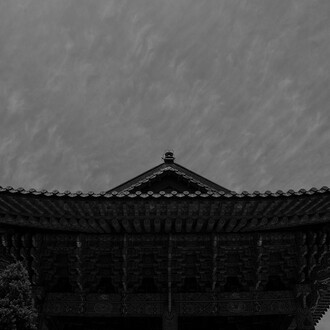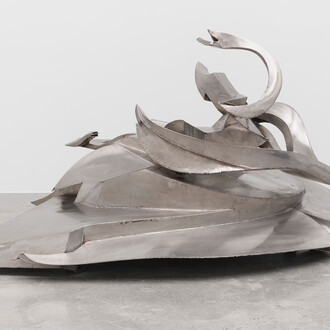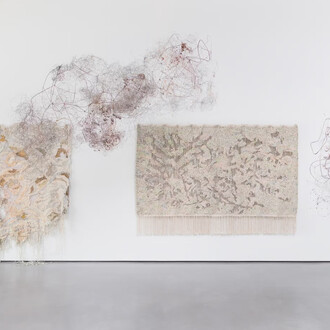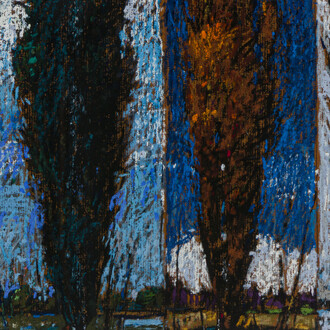Rachel Uffner Gallery is pleased to present in the Upstairs Gallery, Jack Arthur Wood’s One thing's sure, I’m here to see those lights.
Jack Arthur Wood’s new, sculptural paintings make a lot of different impressions, although a sense of abstraction is the first and most immediate, heightened by the relentlessness of both collage and color. It’s not an accident that buildings are one of Wood’s primary subjects: the work asserts itself constantly as a construction. Color, in all its gorgeousness, is put to work as a building block. Stained fabric and paper are glued together to create infrastructure, and painted rays and dashes seemingly lace-up surfaces so they can coalesce into form.
Wood’s paintings assemble themselves prismatically into an image, often a sunset or skyscraper dazzling its refractions. The materiality of canvas and collage launches a pull that physically draws toward a surface intensified with details: draped chains shining; edges bound with straps ; loose canvas strings unbothered in their crawl. Gradients stack their radiance in chunks, creating a sense of interrupted and yet undeniable glow.
It is tempting to see this art as visionary, and, especially in smaller works, Wood nods toward traditions of the abstracted landscape as a stage for symbolism, like Agnes Pelton, or as symbol itself, like Forrest Bess. LLN (Future Games) proffers the orbs as jewelry, encased in a plaid sky box with red, yellow, and blue brackets. One gets the sense of an experience meant to be kept, a memory pinned in place by organizing a daydream into a material mnemonic. The Crystalline Prescient Web (Steadfast is the Star), goes even further, its symmetry fixing the image bilaterally as though once was not enough. The web itself, made of delicate chain, suspends two pendants that themselves could be flowers or stars. Decoration is veneration, the image impossible without being arranged.
The suite of large paintings makes space, not only for a more expanded sense of rural and urban landscape, but for historical memories. In Wood’s paintings of architecture, much of it iconic New York City landmarks, Wood depicts a view of the city as much as he does the city-imbued modernism of the American ‘30s. Georgia O’Keeffe’s portraits of buildings, radiating with the spirit that You Are Here, beholding the spectacle of skyscrapers erupting in real time. The suspension of cables and composition, pleated as one and the same, in Joseph Stella’s bridge paintings. The vertiginous, forced perspective of Margaret Bourke-White’s photographs, which taught legions of tourists how a city should be looked at (up, in awe). A hint of Busby Berkeley’s drive toward kaleidoscopic abstraction and eternal return.
Wood invites this tradition in, both longingly and critically. After all, the time is different, and the giddy possibility of new ways of seeing and making space has transformed into a nauseous over-saturation of news and newness, compounded by political, social, ecological despair. But thinking about these modernists charts its own gradient traversing photography, collage, and painting; from index to visual metaphor to social wish. Wood’s paintings move similarly. In the American Radiator, and Zenith of No Evident Logic (Empire Light), the buildings announce themselves with familiarity, knowing they will be recognized as icons. American Radiator is the most solid, a real building, and the light around it seems to emanate from it, obeying the reflective logic of its steel-and-glass character. In Zenith of No Evident Logic (Empire Light), things start to get weird, unstable, the exterior gradient patches penetrating the form of the building. The top of the Empire State building floats, at first a beacon and then the apparition it is, living rent free in the conscience of an (ever more expensive) city.
The Light Gate (Chrysler Ruminations) is further unmoored, its quintessentially Deco ornamentation present in wavy cuts, and a sense that the hues have become metallic; the building washes like a scent or an adverb over the painting’s formal arrangement. The idea of the gate takes on metaphorical importance: the icon dissolves into portal, bridge, with no evident destination, reminding us that our present was decided for us and that all of the beauty we might ascribe to these structures cannot erase the problems they caused. Remember that the Empire State Building originated the 24-hour construction cycle; that the utopia promised by the automobile industry failed to deliver the middle-class American Dream even as it exploded the demand for oil at any cost.
By the time we get to Metropolitan Tunnel Time (Purgatory), Wood’s opinion on the matter is clear: the shimmering visions around us are a hellish funhouse with no exit, but it also has its fun. At least we can have the pleasure of the art. The large landscapes follow this logic, fragmented as though we cannot help but see the sun set or rise through industrial spectacles. The convention of the escape into nature is troubled, the horizon unmaking itself in Jellico Inverted (Adolescent Prism). In Spring Rain and Falling Ashes, the landscape has collapsed its volume into the experiential cone of weather, folding perspective back onto the surface of the painting and the body.
The wish: Wood never lets us forget that appearances are dependent on material conditions. We dream from our bodies, and paintings conjure images from canvas and muck. The closer we get to the work, the more pronounced frayed edges and loose threads become, as if to shake us out of the fantasy of the seamlessness of our illusions. If the work begins with abstraction, it ends there too; although perhaps it starts with the issue of how to access an experience as an image, and it ends with the obstinacy and necessity of matter. Here, on the surface, we can see how it feels; and if art can do anything, it can teach us that both environments and the way we interpret them are made.
The title of this show, One thing's sure, I’m here to see those lights begs its own question: what lights, and where? An image of history, a past ideal whose unrealized promise traps even as it seduces? The blaze of embodied memory, simultaneously recalled and dissipating? The uncanny encounter with light itself, the tenacious and yet unknowable translation from the exterior world into the mind? The present as a flicker, projected into an image which is a story for a moment before the sun sets and the light turns off?
(Text by Gaby Collins-Fernandez)
















